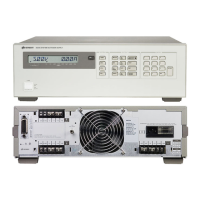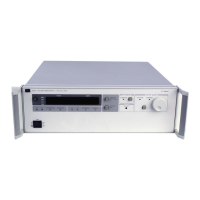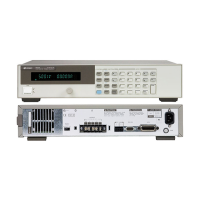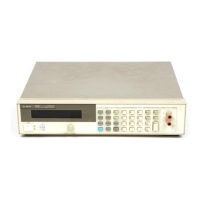Principles Of Operation 79
calibration data in the EEPROM is controlled by the combination of a password and jumper options on a header (J3)
located on the A1 board (see "Post-Repair Calibration" in Chapter 3).
The power supply can be calibrated with front panel keys or over the GPIB (667xA Series) with SCPI (Standard Commands
for Programmable Instruments) commands. The calibration procedure is in Appendix A of the Power Supply Operating
Manual).
A5 Control Board
The A5 Control Board contains the Secondary Interface, the CV/CC (constant voltage/constant current) Control Circuits,
and the Switching/Downprogramming Control circuits. These circuits are shown schematically on Sheets 1 through 3 of the
A5 Control Board schematic.
Secondary Interface
These circuits are shown in detail in the A5 Control Board schematic, Sheet 1, and include the Secondary Microprocessor
IC (U504), the Programmed GAL IC (U502), three DAC/OP amp (digital-to-analog converter/ operational amplifier)
circuits (U507-U512), and Readback Comparator circuits (U503 and U513). The secondary microprocessor translates the
serial data received from the A2 board into a parallel 12-bit data bus. The data bus is connected directly to the three
DAC/OP amplifier circuits. Under control of the microprocessor, the selected DAC converts the data on the bus into an
analog signal. The DAC reference circuit (U505, U517) provides a +10V reference for the CV and CC DACs and a
-11.6V reference for the readback DAC.
A CV DAC/OP amplifier (U507, U508) converts the programmed value of voltage on the bus into the CVPROG signal.
CVPROG is sent to the CV control circuits to control the magnitude of the output voltage in the CV mode. The range of
CVPROG is 0 to -10V, which corresponds to the zero-to-full scale output voltage range of the power supply.
A CC DAC/OP amplifier (U509, U510) converts the programmed value of current on the bus into the CCPROG signal.
CCPROG is sent to the CC control circuits to control the magnitude of the output current in the CC mode. The range of
CCPROG is 0 to -10V, which corresponds to the zero-to-full scale output current range of the supply.
The Readback Comparator circuits (U503, U513) operate with the readback DAC/OP Amplifier (U511, U512) to return the
following signals to the microprocessor:
• The monitored output voltage (VMON).
• The monitored output current (IMON).
• The ambient temperature (AMB_SENSE).
• The programmed voltage value (CVPROG).
• The programmed current value (CCPR0G).
• The fan speed (FAN_SENSE).
The readback DAC circuit is controlled by the microprocessor to successively approximate (to 12-bit resolution) the value
of each signal monitored. The CVPROG and CCPROG signals are used during self test to check operation of the DAC/OP
amplifier circuits. The microprocessor monitors the fan speed (FAN_SENSE) and the supply’s ambient temperature
(AMB_SENSE) in order to generate a FAN_PWM control signal. The pulse width of FAN_PWM is varied according to the
ambient temperature. The signal is applied to the fan speed control circuit on the A4 AC Input Board to increase the fan
speed as temperature increases and decrease the fan speed as temperature decreases.
The Secondary Microprocessor generates OVPROG, a pulse-width modulated signal that represents the programmed
overvoltage protection level. OVPROG is processed by Programmed GAL U502 and U517 to produce OVREF, which is sent
to an OV Comparator circuit (U630 in A5 Control Board schematic, Sheet 3). This circuit compares the actual output
voltage level with OVREF. When the output voltage exceeds OVREF, the OV comparator circuit produces a low-level
OVCMP signal, which is applied to the Programmed GAL (A5 Control Board schematic, Sheet 1). When OVCMP goes true,
the GAL circuit produces a high-level OVSCR signal that causes the following actions to occur:
